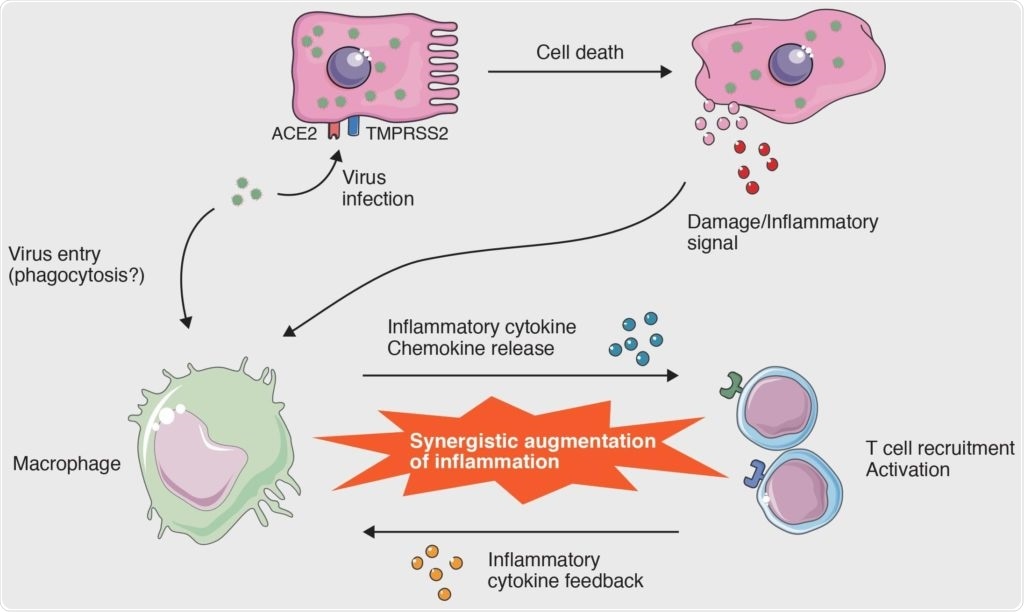A major percentage of COVID-19 cases have become so severe that hospital admissions have become mandatory for both monitoring and treatment. In fact, a significant number of these patients die from COVID-19 disease after they appeared to respond well to treatment.

Macrophage Activation Syndrome in COVID-19. SARS-CoV-2 enters cells via the ACE2 receptor. They cause cell death in lung cells, and these dying cells release cytokines that activate macrophages. Separately, the virus that enters macrophages activates them. These activated macrophages recruit T cells, which in turn activate more macrophages. This becomes a positive feedback loop that leads to MAS and subsequently hyperinflammation. Image Credit: Ryo Otsuka, Ken-ichiro Seino. Inflammation and Regeneration. August 6th, 2020.
The primary cause of these COVID-19-related deaths is a phenomenon known as the cytokine storm, which takes place when hyperactivation of immune cells results in a huge amount of cell signaling molecules, or cytokines, which consequently activate systemic hyperinflammation. If this condition is left untreated, it may result in multiple organ failure and eventually death.
If there is a means to prevent or weaken the cytokine storm, the number of deaths caused by this phenomenon would significantly reduce, decreasing the overall mortality related to COVID-19.
Ryo Otsuka and Ken-ichiro Seino from the Institute for Genetic Medicine (IGM) at Hokkaido University assessed the prevalent study made on macrophage activation syndrome (MAS). The researchers’ study addresses the function played by MAS in the COVID-19 infection, and emphasizes how prevalent treatments for MAS have demonstrated initial success in ameliorating severe cases of COVID-19.
The study was published in the Inflammation and Regeneration journal.
The cytokine storm also occurs in other disorders and diseases, like sepsis, pneumonia, and influenza, and has been analyzed in some detail. Along with MAS, Acute Respiratory Distress Syndrome (ARDS) is an associated syndrome, which is characterized by sudden onset of widespread inflammation in the lungs—a common characteristic of severe cases of COVID-19 infection.
The researchers, thus, assessed the association between ARDS and MAS and the role played by MAS in the COVID-19 infection.
The researchers’ review described that in the case of COVID-19, MAS was accompanied by ARDS and that relatively more cytokines were involved than in the cases of MAS documented earlier. This variation is attributed to the SARS-CoV-2 virus.
When the virus penetrates the cells, it activates an inflammatory response as the cells combat against it. It also activates the inflammatory response by inducing pyroptosis, which is a type of cell death caused when it infects cells, and this, in turn, activates macrophages.
In addition, the virus penetrates macrophages and activates them. Activation of the macrophages leads to recruitment of T cells, which stimulate more macrophages, setting off a positive feedback loop. This leads to MAS that, consequently, causes ARDS, which can be fatal if left untreated.
According to this latest study, MAS is directly activated by cytokines, like Tumor Necrosis Factor α (TNFα) and interleukin-6 (IL-6), and indirectly activated by IL-1. The researchers discussed earlier case studies in which treatments targeting these molecules to suppress the MAS were used.
The new study covered treatments targeting the molecules that induce MAS. This finding could help decrease the severity of COVID-19 infection. Initial trials have been performed on tocilizumab (an IL-6 blocker) for severe cases of COVID-19 infection in China, and also on anakinra (an anti-IL-1 medication) for non-severe cases of COVID-19 infection in Italy, and the outcomes are generally positive.
In addition, a trial was performed on 19 patients in the United States, and these patients were treated with a drug called acalabrutinib that targets the synthesis of IL-1. This drug also had favorable outcomes in severe cases of COVID-19.
At present, several clinical trials are ongoing which involve testing several drugs that act on different stages and aspects of SARS-CoV-2 infection.
The clinical trials that show promise must be replicated on a much larger scale before their effectiveness can be validated. In the process, we may discover clues to a novel treatment.”
Ryo Otsuka, Assistant Professor, Institute for Genetic Medicine, Hokkaido University
Source:
Journal reference:
Otsuka, R & Seino, K-I (2020) Macrophage activation syndrome and COVID-19. Inflammation and Regeneration. doi.org/10.1186/s41232-020-00131-w.